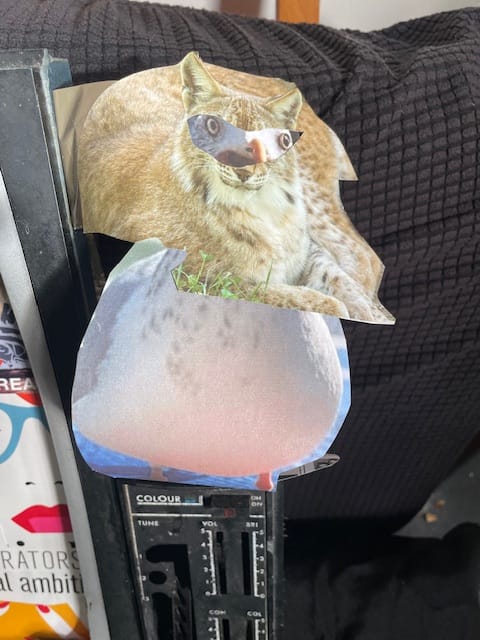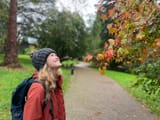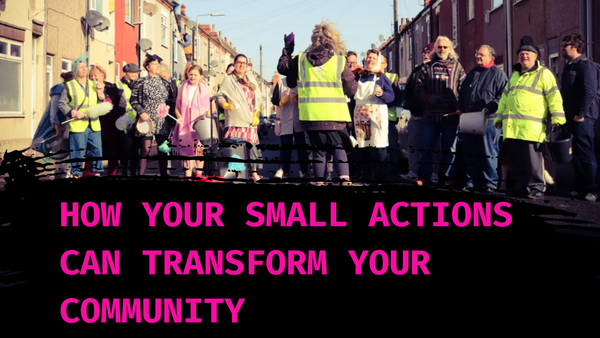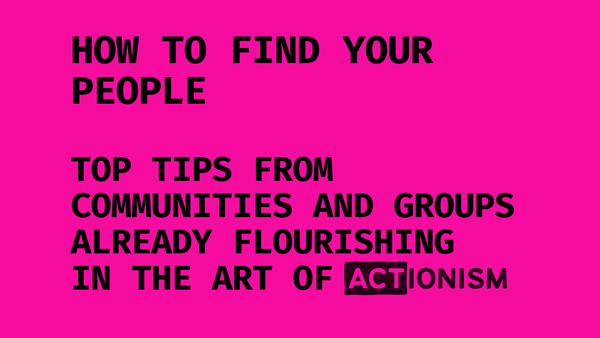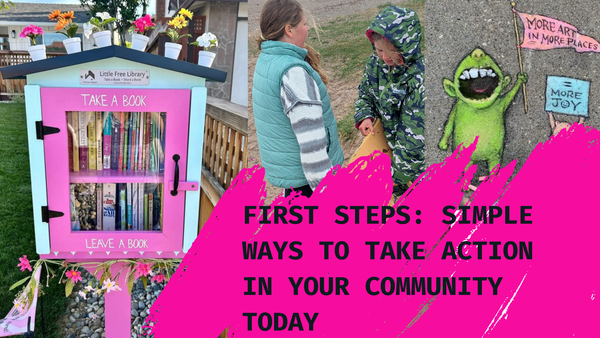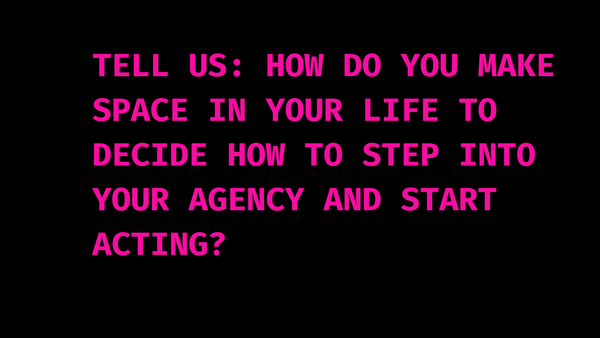The Slow Down Club
I invite you to join me on a rainy Sunday in October. Friends gather round an extendable table in a first-floor Brighton flat for a shared breakfast. We have gathered for the inaugural convening of the Slow Down Club.

The Inaugural Gathering
I invite you to join me on a rainy Sunday in October. Friends gather round an extendable table in a first-floor Brighton flat for a shared breakfast. Pancakes provided by the hosts: toppings provided by everyone else. Plates overflow with giant blueberries (“I’ve genuinely never seen a blueberry that big”), pancakes smeared with peanut butter and pistachio creme (“Two pounds in Lidl, can you believe it?”), and mugs of coffee clutter the table, mostly decaf as none of us can handle the strong stuff anymore (“Is that one mine? No, I think that one’s mine, it’s a half and halfer”). The jar of marmalade sits unopened next to me (“To be fair Olivia, that was a rogue choice”).
We have gathered for the inaugural convening of the Slow Down Club. Also known as ‘Snail Club’ in certain circles (you know who you are).
Born from a collective desire to find some relief from the pace of modern life, the first Slow Down Club is simply a space to reflect and to imagine together. A co-creation of what life might be like with a little more ease, a little more peace, a little less pace.
I want to share the shape of the day with you because this is eminently replicable. I promised you that ‘Learning to Love Where We Live’ would not ask you to do Big Scary Things. I’ve even given up on asking you to have cold showers (shout out to my long-time readers). But I believe that every single one of you reading this could host a Slow Down Club session: whether that’s with your family, your friends or any other community who you think could benefit.
My friend Sam guides us through the day, inspired by Rob Hopkins’ ‘From What Is to What If’. For anyone unfamiliar with Rob and his work, it’s all about inspiring us to imagine in order for us to create the future we want to live in. Amongst the many crises that we bear witness to one of the least talked about is the ‘crisis of imagination’.
Genuinely: when was the last time you took a moment to imagine a positive future that looked radically different from how things look today? And I don’t mean just imagining for yourself. This isn’t about manifesting your dream partner, or dream job, or dream holiday. This is about taking time and space to imagine a positive future for everyone that might look wildly different to how things look now.
It’s not easy to do. We are all so tired, so overstimulated and overwhelmed that we struggle to imagine how different the world could look. When we do imagine a different world, it tends to be dystopic, fuelled by the endless negativity of the media or dark and frightening Black Mirror futures. As Frederic Jameson said “it’s easier to imagine the end of the world than the end of capitalism.”
And yet imagination is the key to so many of our current challenges. If we could allow ourselves and each other to imagine beyond the dystopic future that currently seems writ in stone then perhaps we might be able to change course, dream something new into being.
Let us return then to our cosy Sunday gathering and friends committing to imagining something new into existence.
Pancakes eaten, marmalade still unopened, we start by closing our eyes and listening to a vision of the future:
Can you picture a softer rhythm to daily life? At night, laying a clear, relaxed head on a welcoming pillow. Uninterrupted dreams, sweet and sound. Waking up in the morning to the light, not the alarm. A stretch, a breath from deep in your belly, your first spot of attention drawn to a scent not a sight. You’ve still got a little sleep in your eyes. The phone stays tucked away. A communal breakfast. Pancakes, panfried, something warm steeping on the stove. The colours of the morning table are a rainbow of fruits, friends and feelings.
When was the last time you stopped to chat with a neighbour? Sharing stories, a helping hand and a well-intentioned smile.
Work still exists, but you know it won’t love you back, so you take it at a pace that is human, that is yours. You feel a sense of belonging and community when you walk through the doors. What you do, you are good at. What you do, brings you joy. What you do, is it good for others too? It makes others happy doesn’t it. I can see that for all of you.
Your bare feet accupressured by the undulating pebbles tendering your soles while you gazing at the ocean horizon. Here, you - don’t find time- you make the time to also tend your soul. You gaze down at your used, but gentle loving hands. Looking closely, you spot a little residue dirt under a nail from your last garden session. Or are you still feeling the softness of last night’s self-care routine – moisturised hands, a face mask and a book. Candles and incense of course. Sometimes this is about “me time”. But sometimes you share this intimate space with others.
Evenings invite rest and connection, playing music, cooking together, are you learning an instrument or a new skill?
Each day is punctuated by small rituals of gratitude like closing your eyes, taking long deep breathes, writing a note, taking time to breathe deeply before speaking. The pace of life allows for depth – about quality over quantity. It is about feeling. Every synapse tingling with the sensation of a grounded calm. In this way, we, all here, move through our days attuned to one another. And by one another, I don’t just mean humans.
The idea of productivity has shifted; attention and care are how we check in with ourselves. This is directed inwards as well as outwards. Strapping your oxygen mask first before attending to others. So long as you do also attend to others, there remains a healthy balance. Meetings with friends and families often happen outdoors, around shared meals or in circles that begin with a few moments of stillness – maybe a little silliness. Each mouthful is mindful. Except you’re not eating your nails anymore. With a bowl of warm food on your lap – we never begin without acknowledging our internal gratitude to everything and everyone that helped the bowl reach your hands. Chewing more than 15 times before your food begs to deep dive, please brush your teeth.
There are infinite potential ways we could choose to live our lives. Do these resonate? What do you see when you close your eyes? What motivates you being here, wanting to slow down?
We’re going to take a minute or so for silence and stillness to let some of these thoughts settle.
What Is?
We sit around a simple piece of card. In the middle are the words ‘What Is?’.
What has brought this group of people here today? From the global machinations of tech billionaires manipulating our brains to keep us addicted to the devices and applications they want to sell us to the daily feeling of just being quite overwhelmed to be honest. Or maybe they’re the same thing.
We take a moment to think about this question. And then we begin to write: in all different directions and colours and sizes. Some of us draw instead of writing. A picture emerges:
- PHONE ADDICTION
- Disconnection
- Nervous system dysregulation
- My alarm clock rules my life
- Constantly chasing dopamine hits
- OVERWHELMED !!!
But in the inbetweens the seeds of something else are already emerging, the things that we are already wanting and dreaming into existence:
- I want to learn to embrace boredom
- There’s so much to be curious about
After we’ve spent a good few minutes writing, doodling and reflecting, we each share what we wrote and what brought us here. Colour, humanity and depth is added to the words. We learn about polyvagal theory and that most of us spend our life stuck in a “sympathetic state” colloquially known as the “fight or flight response” because the pace of modern life means that our systems perceive threats and danger even where there are none. Someone tells us about their intentions to pause before reaching for a screen to numb out the exhaustion of the working day and learn to just sit in the discomfort. I talk about my ongoing intentions to lean into curiosity and love rather than fear. And to stop going on Buzzfeed and taking “What kind of cupcake are you?” quizzes (red velvet, in case you were wondering).
We take another few minutes to add to our co-created cardboard with reflections on what we’ve just heard and some of the more positive, warm and fuzzy feelings it’s created in us. New things appear:
- “Brighton community” (in a heart) “new friends” (in a different pen, wrapped around it)
- A snail
- Connection
What If?
Now it’s time for the really juicy part. Allowing our imaginations to run rampant. Allowing ourselves to ask “What if…?”
What if we had the time and energy to be creative every day? What if we regularly had intergenerational communal meals? What if we cared for each other through lending a hand when work is busy, and quiet hugs on sofas when energy is low?
What if we all spent much more time outside? Ooh, what if we had wild lynx flourishing in the UK? Wait wait wait, what if a seagull and a lynx created some kind of incredible seabird wildcat hybrid!? Okay maybe not that last one.
This is where the fun really begins. We have collectively gathered stacks of magazines and I mean stacks. It’s time to collage.
I’ll admit, before I moved to Brighton, I hadn’t collaged in a very long time. It struck me as a bit childish, not something that very adult, very grown up women drinking wine in wine bars or going out to restaurants to catch up about work and love lives would do.
Since I moved, however, I’ve realised that arts and crafts with pals is in fact an excellent way to spend time and something that I intend to do throughout my thirties and beyond. Whether it’s painting each other as vegetables (the image of me as a red-eyed cauliflower remains as a memento of me in my previous house), or creating something together, the act of using our hands and imaginations without it needing to be good or for something in particular is very joyful indeed.
And so this is what we do together on that rainy Sunday afternoon. We dream into what our futures could look like and we cut words, letters and images from magazines to stick on the board around those all important words:
What If?
The sound of scissors, some big, some ludicrously small (“All I had was my penknife! I left my other scissors in London.” “What on earth…”), slices through paper and air. Cut outs and unread articles litter the floor. The board begins to take shape and energy and excitement grows (“What if we put this coming out of her head?”, “and what about this little dude, where should he go?”). This is co-creation in the flesh, gluey-fingered, shouts of laughter and exclamations as everyone stands, shoulder-to-shoulder round the table (“Guys, this is actually SO good.”).
Once we’re done we stand back to admire our handiwork, looking at other corners where we haven’t been so involved, appreciating our creations all the more. Words and phrases leap out, mantras for the future we want to see, the present we want to usher into being.
- “Permission to feel peace”
- “Indulge in: pause, sleep, mellow, love”
- “I love what I do every day”
- “soul soup”
For all of my faux-adult feelings about collaging, I have to say these ones are pretty awesome. They feel like a little rebellious act in the face of a media that tells us to feel sad, bad and mad. By the end we feel good, less 'should' and a little “maybe we could?”.
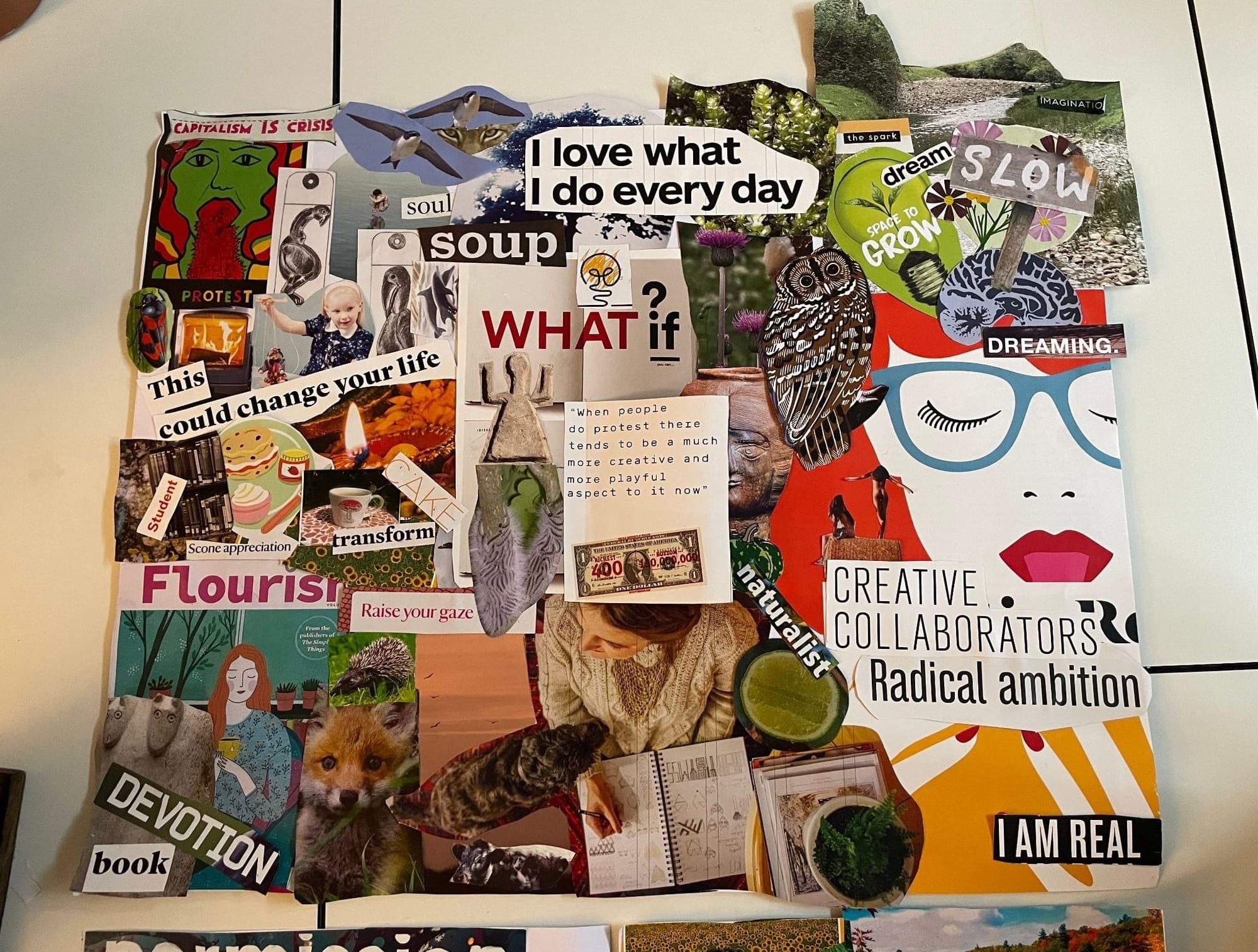

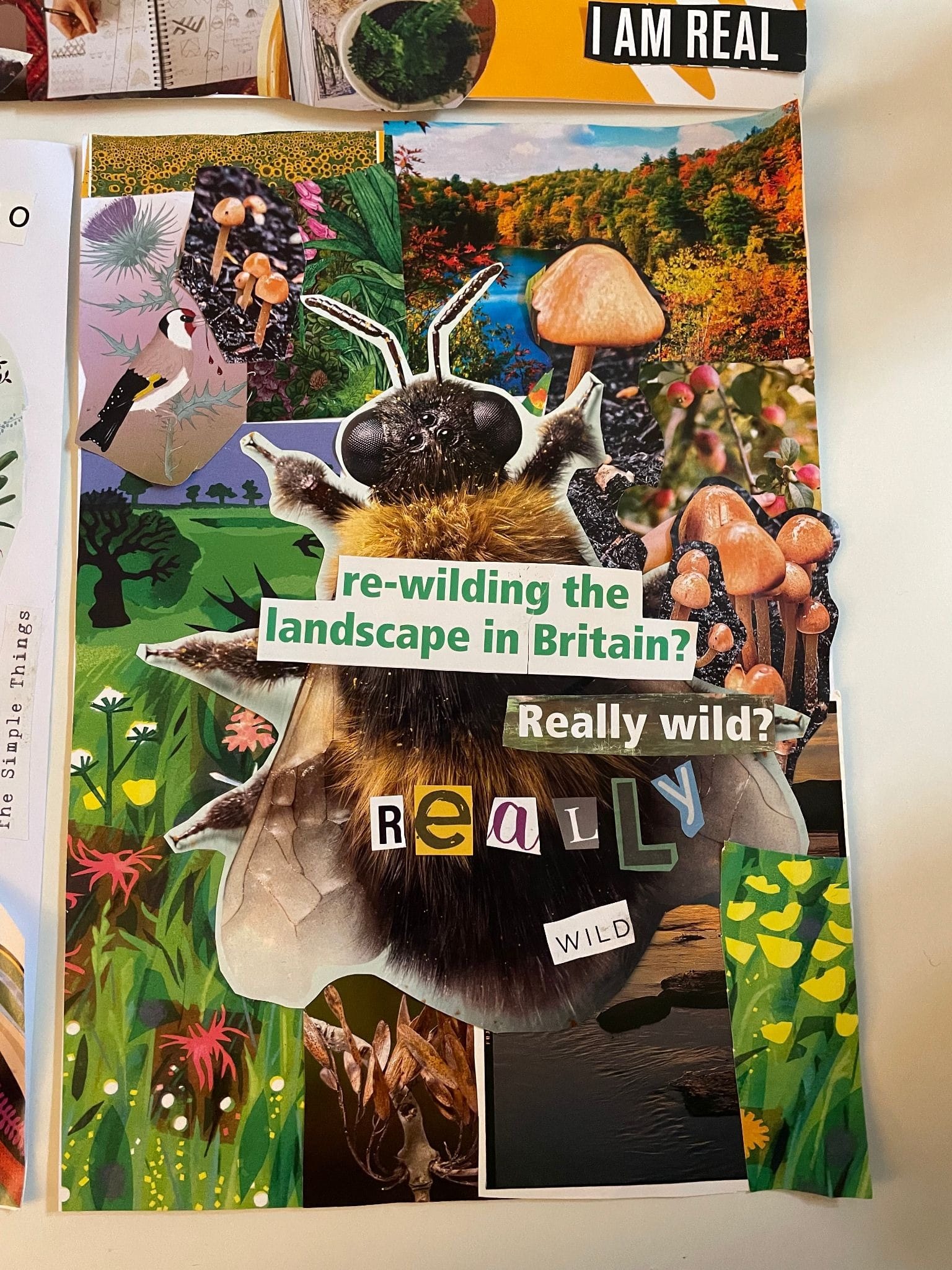
What Next?
My grandmother and father have a wonderful phrase that I have heard many times in my life but never fails to resonate with me: “Strategy is the imagined deemed possible.”
See how the act of imagining is core? In order for us to be able to get closer to a future we want, we must first imagine what that future might be. And then we must take actions to make it real, to make it possible.
You can’t make it real all at once of course. You must start with a small step. Something that gets you a little closer and then another step that gets you closer still. This is easier when you have others around you. A step taken in isolation can feel intimidating, venturing down an unknown path and not sure what you might find underfoot. If you know that there’s another taking a step alongside you then it’s easier to wander into the dark.
And in that spirit, we reach our final activity of the day. Energy has dipped after the tea and the excitement of the collaging, so we close our eyes and tune in for the second half of Sam's vision for the future.
The power of small actions should never be underestimated. Slowing down is a radical act that ripples outward. Let’s fast forward to the year 2035 and much has changed. We still face social, environmental, economic and political challenges: inequality, unrest and AI, to name a few. But it can’t be ignored that we’re moving in the right direction. See, local currencies are thriving. Small businesses are becoming the norm. Footfall in market streets is the highest it’s been in generations. Urban farms are multiplying. Forests are expanding faster than they’re disappearing. Our more-than-human kin are returning to our coasts, waterways and streets. (David Attenborough, at the ripe age of 109, is still making documentaries about it.)
The invisible hand of the free market no longer grips; it only lightly tickles those chips on our shoulders.
What sort of values become the societal norm when we embrace a slower rhythm of life? And those everyday choices, multiplied across millions of lives, have shifted culture, economics, and even politics. The revolution didn’t begin with grand gestures.It began when we stopped rushing.
And the catalyst you ask? It was when you and your friends gathered, tearing into batter while drinking coffee in communion with the holy trinity of reflection, imagination, and action. The outcome being a crafted manifesto that aligned the stars, harmonized the universe, and attuned to the energy of the eternal slow down.
February 3, 2034 – the next time when we witness a planetary parade – the almost total alignment of seven planets in our galaxy – slowing down occurred on a scale never before seen. At this point, the pandemic became just an irrelevant bit of yesterday’s news. People’s average speeds halved overnight, 300000000% less energy was spent watching trash, 20000000000000 more hugs were shared compared to the previous day. And for the first time since the late 1700s when the Scottish engineer, James Watt’s contribution to the steam engine became the foundational technology that ushered in era of industrialisation, love and connection surpassed fossil fuels as the number 1 energy source. Interestingly, however, the unexpected happened… British politics was sent into a snap election with almost all parties dissolving effortlessly into a healthy state of chill. Tories – gone. Kemi Badenoch – more like Kemi’s in Bed with socks. Labour – gone. Sir Keir Starmer – more like Sir Here’s an Urban Farmer. Lid Dems – gone. Surprisingly. If there was ever a politician that embodies the fun, silly vibes it’s Ed Davey – ahem* I mean more like Chillerman Head Wavey. Reform – sadly still going but only down to the one-man band of Farage. Shame because his name would have gone down a treat with a foraging-based pun. But from the ashes to challenge the nutty mania was Albert Einslime and Mary Anning-from-a-tree, the co-leaders of the new political party, Snail Sloths Slow Down Club.
In this two v one bake beaned up sauce fest fight between Reform and the Snail Sloths Slow Down Club, a future hangs in the balance. Nevertheless, it can’t be underestimated that Farage is outnumbered and the power of the collective always rests in the togetherness of connection and creativity. And so, together, between the slimey palm of Albert Snail and the death grip of Mary Sloth, they raise their manifesto, and it shows…
What does your slow down manifesto show? What is that world you seek to reimagine and rebuild? Whatever it is I am sure it is beautiful. Is the future one where we are harder to contact but when we do meet each other, our presence is unmatched. Our attention to one another is caked in adoring care, insatiable laughter and is totally undistracted. Is it one where we’d go to bed each night without screen time overloading our senses, fracturing our attention and depleting our mental reserves? What if silence was a state we could access at will so we can turn down external volume and turn up internal insight? What if green spaces were less than a hop, skip and jump away? What if it was possible to carve out more opportunities for creative hobbies? What if we, altogether, cultivated a life of gratitude? So, what do you see? Our motivations may be diverse and plenty. I know our lives truly are. Maybe it is the world that we reimagine and rebuild together. Welcome to the future – it is right here, right now. Present, intentional and in safe loving company.
After we have laughed and congratulated Sam for 'Albert Einslime', we get ready for our final activity of the day. I hold the pen to the last piece of blank card, noting and doodling what I hear so that others can just talk and share how they feel. We discuss what we might do next, what matters to us and how we might begin to show up slightly differently in the world. The conversation ranges from the concrete (reading together, creating together, playing together, “You know, I’ve actually always wanted to try Dungeons and Dragons”), to the ephemeral (patience and actually noticing the world around us).
We come up with some guiding principles that feel important:
1. We need to create spaces where people can come exactly as they are.
Somewhere along the way, recharging seems to have become a solo activity. Self-care spins the narrative that peace can only be found alone, that to be with others we must be energetic and funny and that if we are not feeling those things it will be better for all involved if we stay home. Can we create safe spaces for each other to exist in all our states, can we begin to create homes away from home?
2. Making changes is easier together.
It’s a difficult thing to decide that you’re deleting Instagram or WhatsApp or that you’re going to introduce a phone free day when no one is doing it with you. It’s also hard to have a pot-luck on your own as it turns out. But having each other means being able to share challenges and wins, tips and alternative plans to scrolling the night away.
3. It’s okay to try.
This part was twofold. All of us felt the need to rethink our relationships with productivity and perfectionism and this extends to the creation of Slow Down Club. We agree that it will emerge as it emerges at the pace that feels right. We agree that it’s okay if you put a suggestion out there and it doesn’t work out. It’s okay to say you’re going to watch the starlings and does anyone want to come and to not get a response. It’s okay.
And so, with these principles agreed, a vague suggestion of when the next session should be (it feels wrong somehow to get our phones out to plan) the inaugural meeting of The Slow Down Club winds down. A group hug cements the feeling of connection. Boots go on feet, arms stuffed into winter coats (“Thank you for having us! Those pancakes were genuinely delicious”), unopened marmalade tucked safely back into bag, and the group disbands into the seaside gloaming. For now at least.
So there you have it: your first challenge, should you choose to accept it.
Host your very own Slow Down Club.
You can use ours as a guide but feel free to be creative. Make it yours. If you've got kids then use this as an entertaining afternoon activity to think about what life would have been like before Peppa Pig and Bluey. If you're an organisation use it as a way to think about prioritising the important work over the urgent work.
Because the first rule of the Slow Down Club? You talk about Slow Down Club.
And if you do want to join our little snail revolution, please reach out and let me know, I’d love to hear about it.
Oh and P.S. If you'd like to know what happened to that seagull lynx-hybrid, look a little more closely at the top right hand corner of the header image.
Turns out anything is possible.
